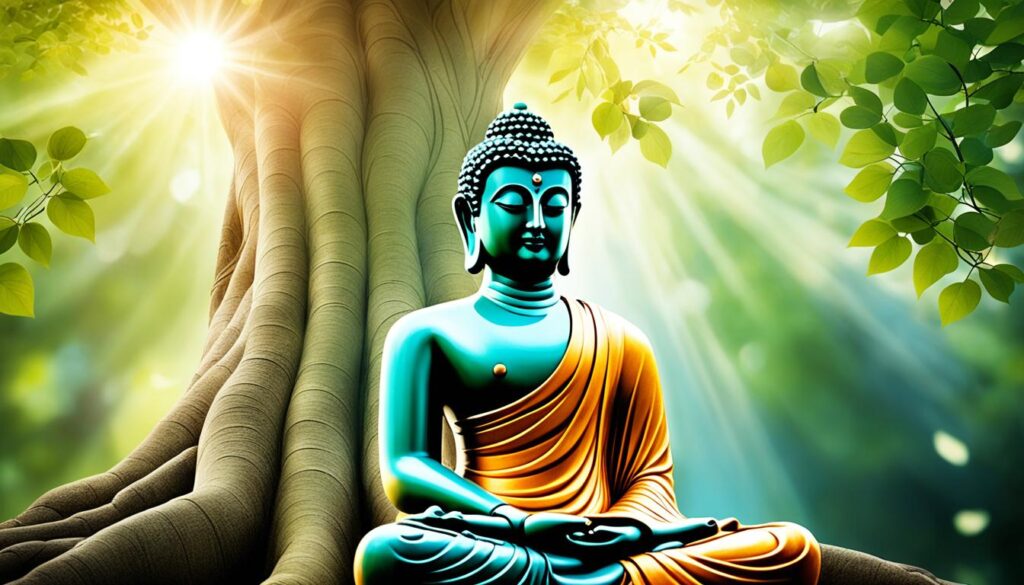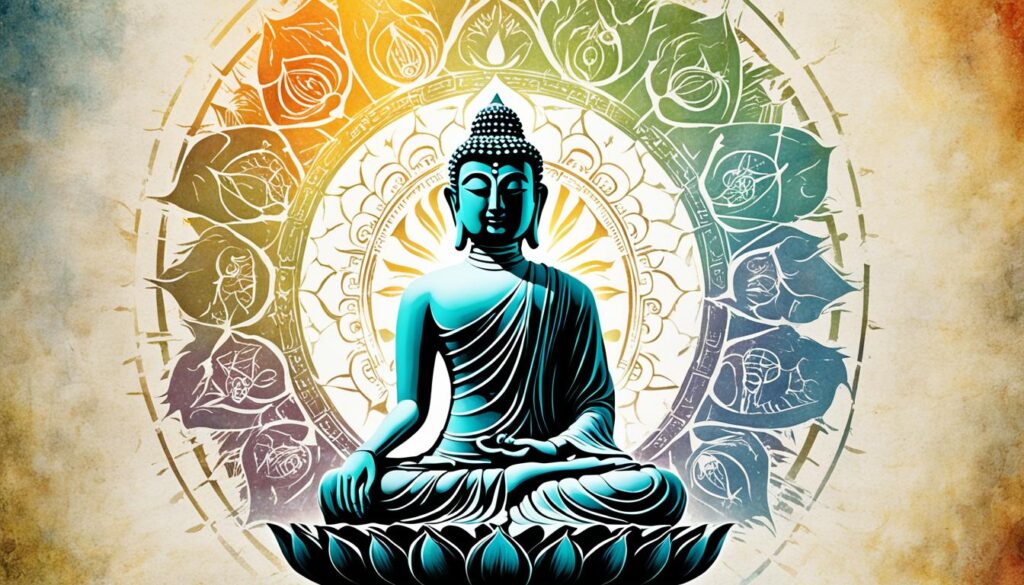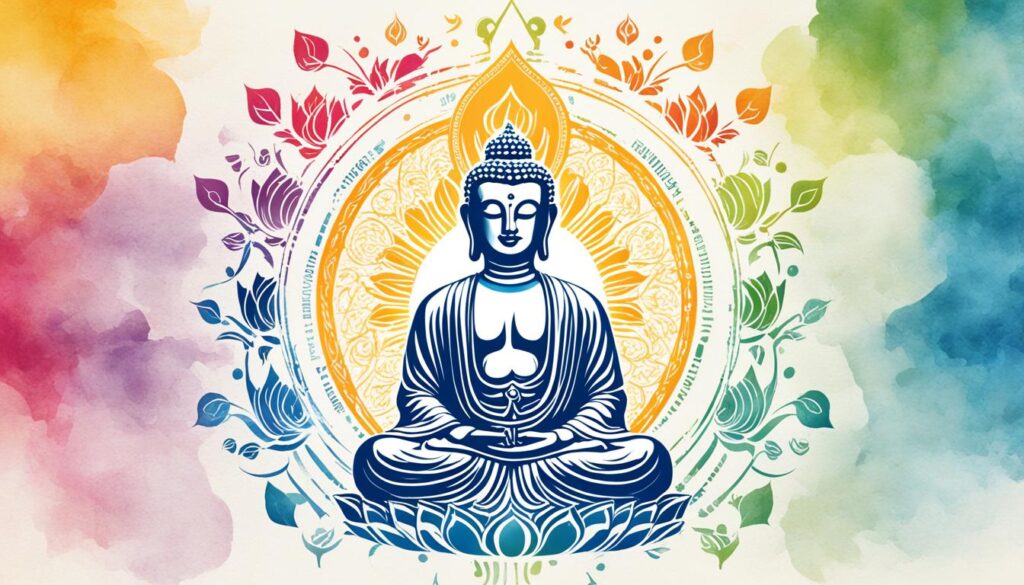“Do not dwell in the past, do not dream of the future, concentrate the mind on the present moment.” – Buddha
Welcome to the world of Buddhism, a profound and ancient philosophy that offers insights into the nature of existence and the path to inner peace. With its core beliefs and teachings, Buddhism provides guidance for individuals seeking enlightenment and liberation from suffering. Whether you are new to Buddhism or curious about its fundamental principles, this article will explore the major beliefs of Buddhism and shed light on its rich and diverse traditions.
Key Takeaways:
- Buddhism is a non-theistic religion focused on achieving enlightenment and inner peace.
- The major beliefs of Buddhism revolve around suffering and the path to liberation.
- Buddhism emphasizes the pursuit of enlightenment, morality, meditation, wisdom, karma, and reincarnation.
- There are different types of Buddhism practiced worldwide, including Theravada, Mahayana, Tibetan, Zen, and Nirvana Buddhism.
- The Four Noble Truths and the Eightfold Path are essential teachings in Buddhism for understanding suffering and achieving liberation.
Now, let’s dive into the fascinating world of Buddhism and explore the key beliefs and practices that have guided millions of people on their spiritual journey.
The Founder of Buddhism
In the 5th century B.C., Siddhartha Gautama, also known as the Buddha, laid the foundation of Buddhism. Born into a wealthy family in present-day Nepal, Siddhartha enjoyed a life of privilege and comfort. However, his encounters with the suffering of others deeply affected him and prompted him to embark on a spiritual journey in search of the meaning of life.
Renouncing his opulent lifestyle, Siddhartha sought enlightenment through meditation and self-reflection. It was under a Bodhi tree that he finally achieved his goal, attaining a state of profound understanding and liberation from suffering. From that moment on, Siddhartha dedicated his life to teaching others about his spiritual discoveries.
Throughout his teachings, the Buddha emphasized the importance of personal transformation and the cultivation of compassion towards oneself and others. He taught that ultimate peace and liberation could be found by following the Eightfold Path, a set of principles that encompass ethical conduct, mindfulness, and wisdom.
The Buddha’s profound insights continue to inspire millions of people around the world to this day. His teachings serve as a guiding light for those seeking enlightenment and liberation from suffering.

“Peace comes from within. Do not seek it without.” – Siddhartha Gautama
Buddhism Beliefs and Practices
Buddhism is a profound philosophy and way of life that focuses on achieving enlightenment, the ultimate state of inner peace and wisdom. Its beliefs and practices encompass various elements that guide individuals in their spiritual journey.
The Essence of Buddhism
At the core of Buddhism is the rejection of the existence of a supreme god or deity. Instead, Buddhists recognize the Buddha as an enlightened being, a teacher who discovered the path to liberation.
Central to Buddhist beliefs is the importance of morality, meditation, and wisdom. These practices aim to cultivate good conduct, develop mindfulness, and expand one’s understanding of the nature of reality.
The Noble Eightfold Path
A fundamental aspect of Buddhism is the Noble Eightfold Path, which serves as a guide for leading a virtuous and fulfilling life. This path encompasses eight interconnected principles, including Right View, Right Intention, Right Speech, Right Action, Right Livelihood, Right Effort, Right Mindfulness, and Right Concentration.

The Four Noble Truths
To comprehend the teachings of Buddhism, one must understand the Four Noble Truths. These truths, revealed by the Buddha, offer profound insights into the nature of suffering and the path to liberation.
- The Truth of Suffering: All beings experience suffering and dissatisfaction throughout their lives.
- The Truth of the Cause of Suffering: Suffering arises from attachment, desire, and ignorance.
- The Truth of the Cessation of Suffering: By letting go of attachment and desire, one can attain liberation from suffering.
- The Truth of the Path to the Cessation of Suffering: The Noble Eightfold Path leads to the cessation of suffering and the attainment of enlightenment.
Karma and Reincarnation
Karma is a fundamental concept in Buddhism, representing the law of cause and effect. It suggests that our actions in this life have consequences in future lives, shaping our experiences and circumstances.
Moreover, Buddhism acknowledges the idea of reincarnation, the continuous cycle of birth, death, and rebirth. This notion suggests that individuals are born into different forms based on their past actions and state of mind.
Worship and Rituals
Followers of Buddhism have the freedom to worship in temples or in the comfort of their own homes. Temples serve as spiritual sanctuaries where practitioners can connect with the teachings of the Buddha and engage in various rituals.
Additionally, Buddhist monks, dedicated to a life of spiritual practice, follow a disciplined code of conduct that includes celibacy. They provide guidance and support to the Buddhist community, serving as role models and teachers.
Overall, Buddhism’s beliefs and practices offer a profound and transformative path towards enlightenment, guiding individuals to cultivate morality, meditation, and wisdom in pursuit of inner peace and liberation from suffering.
| Type of Practice | Description |
|---|---|
| Theravada Buddhism | Focuses on the original teachings of the Buddha and emphasizes meditation and mindfulness. |
| Mahayana Buddhism | Places importance on compassion and the belief in the existence of bodhisattvas, enlightened beings who postpone their own liberation to help others. |
| Tibetan Buddhism | Incorporates elements of shamanism and features rituals, mantras, and the recognition of the Dalai Lama as a spiritual leader. |
| Zen Buddhism | Emphasizes meditation and direct experience to reach enlightenment, often through practices like seated meditation (zazen). |
| Nirvana Buddhism | Highlights the pursuit of nirvana, the ultimate state of liberation and extinguishment of suffering. |
Types of Buddhism
There are several types of Buddhism practiced around the world. The three main types are:
Theravada Buddhism
Image: Theravada Buddhism
Theravada Buddhism, also known as the School of the Elders, is the oldest surviving branch of Buddhism. It is practiced primarily in Southeast Asia, including countries like Thailand, Cambodia, and Myanmar. Theravada Buddhists follow the Pali Canon, the ancient scriptures, and focus on individual liberation through practices such as meditation and moral discipline. The ultimate goal in Theravada Buddhism is to attain Nirvana, the state of liberation from suffering.
Mahayana Buddhism
Image: Mahayana Buddhism
Mahayana Buddhism is the largest branch of Buddhism and is practiced mainly in East Asia, including countries like China, Japan, and Korea. Mahayana Buddhists believe in the Bodhisattva ideal, which emphasizes compassion and the path of the Bodhisattva, who seeks enlightenment not only for oneself but for the benefit of all beings. Mahayana Buddhism includes various schools and traditions, such as Zen, Pure Land, and Tibetan Buddhism.
Tibetan Buddhism
Image: Tibetan Buddhism
Tibetan Buddhism, also known as Vajrayana Buddhism, is practiced in Tibet, Nepal, Bhutan, and parts of China and Mongolia. Tibetan Buddhism places a strong emphasis on rituals, meditation, and spiritual practices. It incorporates tantric teachings and rituals, aiming to achieve enlightenment rapidly. Tibetan Buddhism is known for its colorful artwork, intricate mandalas, and the institution of the Dalai Lama.
These three types of Buddhism have distinct characteristics, practices, and philosophies but share a common aim of attaining enlightenment and liberation from suffering.
| Type of Buddhism | Key Characteristics | Main Regions of Practice |
|---|---|---|
| Theravada Buddhism | Focus on individual liberation and meditation | Southeast Asia (Thailand, Cambodia, Myanmar) |
| Mahayana Buddhism | Emphasis on compassion and the Bodhisattva ideal | East Asia (China, Japan, Korea) |
| Tibetan Buddhism | Rituals, meditation, and tantric practices | Tibet, Nepal, Bhutan, parts of China and Mongolia |
The Four Noble Truths and the Eightfold Path
In Buddhism, the Four Noble Truths and the Eightfold Path form the core teachings that guide individuals towards enlightenment and liberation from suffering. These profound concepts lay the foundation for understanding the nature of existence and offer a path to transcendence.
The Four Noble Truths
- Dukkha: The Truth of Suffering
- Samudaya: The Truth of the Origin of Suffering
- Nirodha: The Truth of the Cessation of Suffering
- Magga: The Truth of the Path to the Cessation of Suffering
The First Noble Truth acknowledges the existence of suffering in life, recognizing that it is inevitable and universal. The Second Noble Truth examines the root causes of suffering, which are desire, attachment, and ignorance. The Third Noble Truth offers hope by explaining that suffering can be overcome and that liberation is attainable. Finally, the Fourth Noble Truth introduces the Eightfold Path as the means to achieve this liberation.
The Eightfold Path
- Right View: Having an accurate understanding of the nature of existence and the causes of suffering
- Right Intention: Cultivating wholesome intentions and letting go of harmful desires
- Right Speech: Speaking truthfully, kindly, and wisely
- Right Action: Acting in ways that are ethical, compassionate, and non-harming
- Right Livelihood: Engaging in a profession that promotes well-being and avoids harm
- Right Effort: Cultivating the energy and determination to cultivate positive qualities and overcome negative ones
- Right Mindfulness: Being fully present and aware of one’s thoughts, feelings, and actions
- Right Concentration: Developing deep states of concentration through meditation, leading to insight and liberation
The Eightfold Path provides a comprehensive framework for personal transformation. It encompasses ethical conduct, mental cultivation, and wisdom, allowing individuals to develop a holistic approach towards liberation from suffering and the attainment of enlightenment.

| Noble Truth | Description |
|---|---|
| 1 | The Truth of Suffering: Recognizing the existence of suffering in life |
| 2 | The Truth of the Origin of Suffering: Identifying the causes of suffering (desire, attachment, and ignorance) |
| 3 | The Truth of the Cessation of Suffering: Realizing that suffering can be overcome and liberation is attainable |
| 4 | The Truth of the Path to the Cessation of Suffering: Understanding the Eightfold Path as the means to achieve liberation |
Buddhist Scriptures and the Dalai Lama
In Buddhism, the importance of sacred texts and scriptures cannot be overstated. These holy books serve as guides and sources of wisdom for followers, providing insights into the teachings of the Buddha and the path to enlightenment. Some of the most revered and widely studied texts in Buddhism include the Tipitaka, Sutras, and the writings of the Dalai Lama.
The Tipitaka, also known as the “Three Baskets,” is the earliest and most authoritative collection of Buddhist scriptures. It is divided into three sections: the Vinaya Pitaka (rules and regulations for monastic discipline), the Sutta Pitaka (discourses of the Buddha), and the Abhidhamma Pitaka (philosophical analysis and interpretation).
The Sutras, on the other hand, are individual discourses or teachings attributed to the Buddha. These texts cover a wide range of topics, including ethics, meditation, mindfulness, and the nature of reality. They provide practical guidance for followers on how to lead a virtuous and enlightened life.
One prominent figure in Buddhism is the Dalai Lama. The Dalai Lama is the spiritual leader of Tibetan Buddhism and is considered an embodiment of compassion and wisdom. His teachings and writings, including books such as “The Art of Happiness” and “The Book of Joy,” provide profound insights into the human experience, compassion, and the practice of mindfulness.
As a symbol of the peaceful and compassionate nature of Buddhism, the Dalai Lama’s influence extends beyond the borders of Tibet and resonates with people from different cultures and backgrounds.
Comparison of Buddhist Holy Books
| Scripture | Meaning | Key Teachings |
|---|---|---|
| Tipitaka | “Three Baskets” | Rules of monastic discipline, discourses of the Buddha, philosophical analysis |
| Sutras | Discourses or teachings | Morality, meditation, mindfulness, nature of reality |
| Writings of the Dalai Lama | Teachings and wisdom | Compassion, mindfulness, human experience |
Buddhism Today
Buddhism continues to thrive in the 21st century, with millions of followers around the world. Its profound teachings and practical applications have resonated with people across different cultures and backgrounds. Today, approximately 488 million people practice Buddhism globally, making it one of the major religions in the world.
The majority of Buddhists reside in countries such as China, Japan, Korea, and Vietnam, where Buddhism has a rich historical and cultural presence. However, the practice of Buddhism has also gained significant popularity among Western converts, who are drawn to its wisdom, mindfulness practices, and emphasis on inner peace and compassion.
Buddhism has adapted to the modern world, giving rise to contemporary Buddhist movements that address the challenges of today’s society. One such movement is socially engaged Buddhism, which seeks to apply Buddhist principles to social issues and advocate for positive change. Socially engaged Buddhists actively work towards alleviating suffering, promoting social justice, and caring for the environment.
Another modern movement in Buddhism is the exploration of mindfulness and meditation in secular contexts. Contemporary Buddhist practitioners and scholars have introduced mindfulness practices to various fields, including healthcare, education, and psychology, to enhance well-being and promote mental health.

In an era marked by rapid change and uncertainty, Buddhism continues to offer individuals a source of inspiration, guidance, and refuge. Its teachings encourage self-reflection, compassion towards oneself and others, and the cultivation of wisdom. As contemporary Buddhism evolves, it remains a source of solace, wisdom, and moral compass for many in our complex and interconnected world.
| Buddhism Today: Key Aspects | Description |
|---|---|
| Socially Engaged Buddhism | A movement that applies Buddhist principles to address social issues and promote positive change. |
| Mindfulness and Meditation | The exploration of mindfulness practices in secular contexts, such as healthcare, education, and psychology. |
| Global Reach | Buddhism’s presence is significant in countries like China, Japan, Korea, Vietnam, and it has gained popularity among Western converts. |
| Adaptation to Modern Challenges | Buddhism continues to evolve to address the unique challenges of the modern world, providing practical guidance for individual and societal well-being. |
Conclusion
Embracing Buddhism can be a transformative journey towards greater understanding, compassion, and insight into the nature of existence. Buddhism offers profound teachings and practices that can guide individuals towards inner peace and wisdom. By embracing the major beliefs of Buddhism, you can find a path to enlightenment and liberation from suffering.
The core principles of Buddhism, including morality, meditation, and wisdom, provide valuable insights for personal and societal harmony. Whether you choose to practice Buddhism in its various forms or integrate it with other philosophies, the teachings of Buddhism continue to inspire and transform lives around the world.
Through the practice of Buddhism, you can embark on a path of self-discovery and cultivate a deeper understanding of yourself and the world around you. The principles of Buddhism encourage you to live a moral and ethical life, cultivate mindfulness through meditation, and develop wisdom through the study of Buddhist teachings.
Embracing Buddhism is not limited to individuals seeking spiritual fulfillment; it is a philosophy that can benefit anyone looking to enhance their well-being and navigate life’s challenges with greater resilience and compassion. By embracing Buddhism, you open the door to a transformative journey towards a more meaningful and fulfilling existence.
FAQ
What are the major beliefs of Buddhism?
The major beliefs of Buddhism include the pursuit of enlightenment, the importance of morality, meditation, wisdom, and the acceptance of concepts such as karma and reincarnation.
Who is the founder of Buddhism?
The founder of Buddhism is Siddhartha Gautama, also known as the Buddha.
What are the core principles of Buddhism?
The core principles of Buddhism include achieving enlightenment, following the Noble Eightfold Path, and recognizing the Four Noble Truths.
What are the types of Buddhism?
The three main types of Buddhism are Theravada Buddhism, Mahayana Buddhism, and Tibetan Buddhism.
What are the Four Noble Truths and the Eightfold Path?
The Four Noble Truths explain the nature of suffering and how to overcome it, while the Eightfold Path provides guidance on the path to enlightenment and liberation from suffering.
What are some important Buddhist scriptures?
Some important Buddhist scriptures include the Tipitaka, Sutras, and other sacred texts revered by Buddhists.
How is Buddhism practiced today?
Buddhism is practiced in various forms around the world, with contemporary movements such as socially engaged Buddhism gaining popularity.
What are the benefits of embracing Buddhism?
Embracing Buddhism can lead to greater understanding, compassion, and insight into the nature of existence, providing a path to inner peace and wisdom.

